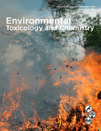Environmental Toxicology and Chemistry 31(11)
Overview of articles on POPs in a new issue of the Environmental Toxicology and Chemistry journal.

pages 2445–2455
Donna L. Cullon, Mark B. Yunker, Jennie R. Christensen, Robie W. Macdonald, Michael J. Whiticar, Neil J. Dangerfield and Peter S. Ross
- Polychlorinated biphenyl (PCB) biomagnification was characterized in a harbor seal food web in the Strait of Georgia, British Columbia, Canada.
pages 2472–2481
Anders Ruus, Ingrid Aarre Daae and Ketil Hylland
- Bioaccumulation of sediment-associated polychlorinated biphenyls (PCBs) was examined in Atlantic cod (Gadus morhua) through direct diffusion from the sediment (via the water phase) and through the food chain (dietary exposure).
pages 2507–2512
Ying Zhang, Jiang-Ping Wu, Xiao-Jun Luo, Ya-Zhe She, Ling Mo and Bi-Xian Mai
- Great concerns have been raised about the fate and effects of polychlorinated biphenyls (PCBs) and other organic contaminants contained in electronic waste (e-waste) exported from industrialized countries at midlatitudes to subtropical and tropical regions. In the present study, 17 MeSO2-PCBs, including five chiral congeners, were detected in the muscle, liver, and brain tissues of two benthic fish species—northern snakehead and mud carp—from a small pond near an electronic waste recycling site in South China.
pages 2545–2556
Steven J. Bursian, Jeremy Moore, John L. Newsted, Jane E. Link, Scott D. Fitzgerald, Nora Bello, Virunya S. Bhat, Denise Kay, Xiaowei Zhang, Steve Wiseman, Robert A. Budinsky, John P. Giesy and Matthew J. Zwiernik
- This study assessed the effects of 2,3,7,8-tetrachlorodibenzo-p-dioxin (TCDD), 2,3,4,7,8-pentachlorodibenzofuran (PeCDF), and 2,3,7,8 tetrachlorodibenzofuran (TCDF) on the incidence of jaw lesions and on hepatic cytochrome P4501A (CYP1A) endpoints in mink (Mustela vison).
(pages 2597–2605)
Shulin Zhuang, Jing Zhang, Yuezhong Wen, Chunlong Zhang and Weiping Liu
- Molecular dynamics (MD) simulations were applied to probe the molecular recognition process of DDT and its five analogs, including dichlordiphenyldichloroethylene (DDE), dichlorodiphenyldichloroethane (DDD), methoxychlor (MXC), p,p′-hydroxy-DDT (HPTE), and dicofol by human estrogen receptor (ER) α and human ER-related receptor (ERR) γ.
19.10.2012




